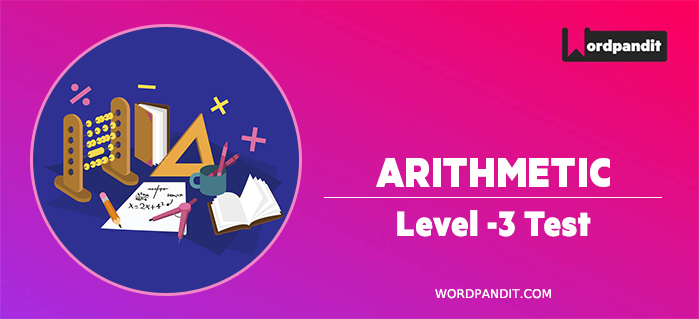- This is an assessment test.
- To draw maximum benefit, study the concepts for the topic concerned.
- Kindly take the tests in this series with a pre-defined schedule.
Arithmetic : Level 3 Test -3
Congratulations - you have completed Arithmetic : Level 3 Test -3.You scored %%SCORE%% out of %%TOTAL%%.You correct answer percentage: %%PERCENTAGE%% .Your performance has been rated as %%RATING%%
Your answers are highlighted below.
Question 1 |
A college has raised 75% of the amount it needs for a new building by receiving an average donation of Rs. 600 from the people already solicited. The people already solicited represent 60% of the people the college will ask for donations. If the college is to raise exactly the amount needed for the new building, what should be the average donation from the remaining people to be solicited?
Rs. 300 | |
Rs. 250 | |
Rs. 400 | |
Rs. 500 |
Question 1 Explanation:
let the number of people asked for the donation = p
The people already solicited represent 60%
Therefore People already solicited = 0.6p
Average donation = Rs. 600
Therefore the amount raised = 600 × 0.6p = 360p
Therefore this money is the 75% of the amount.
Hence, remaining 25% = 120p
Therefore Average donation from remaining people
=120p/0.4
= 300.
The people already solicited represent 60%
Therefore People already solicited = 0.6p
Average donation = Rs. 600
Therefore the amount raised = 600 × 0.6p = 360p
Therefore this money is the 75% of the amount.
Hence, remaining 25% = 120p
Therefore Average donation from remaining people
=120p/0.4
= 300.
Question 2 |
A student took five papers in an examination, where the full marks were the same for each paper. His marks in these papers were in the proportion of 6 : 7 : 8 : 9 : 10. In all papers together, the candidate obtained 60% of the total marks. Then the number of papers in which he got more than 50% marks is
2 | |
3 | |
4 | |
5 |
Question 2 Explanation:
Marks are in the ratio = 6 : 7 : 8 : 9 : 10
Let the marks be 6x, 7x, 8x, 9x and 10x
Average score = 60%
Therefore their average score will be
{6x + 7x + 8x + 9x + 10x} / 5
⇒ 8x = 0.6
⇒ x = 0.075
So the marks are 0.45, 0.525, 0.6, 0.675 and 0.75.
Number of times the marks exceed 50% is 4.
Let the marks be 6x, 7x, 8x, 9x and 10x
Average score = 60%
Therefore their average score will be
{6x + 7x + 8x + 9x + 10x} / 5
⇒ 8x = 0.6
⇒ x = 0.075
So the marks are 0.45, 0.525, 0.6, 0.675 and 0.75.
Number of times the marks exceed 50% is 4.
Question 3 |
The owner of an art shop conducts his business in the following manner: every once in a while he raises his prices by X%, then a while later he reduces all the new prices by X%. After one such up-down cycle, the price of a painting decreased by Rs. 441. After a second up-down cycle the painting was sold for Rs. 1,944.81. What was the original price of the painting?
Rs. 2,756.25 | |
Rs. 2,256.25 | |
Rs. 2,500 | |
Rs. 2,000 |
Question 3 Explanation:
Let’s do this question by logic
Let us assume that the price was Rs. 100
And then we increase it with 20% then the price will become = Rs. 120
And then we decreased it by 20% then the price will become = Rs. 96
Therefore the ratio of reduced price to the original price is 96/120 = 0.833
Now again if we raise 96 by 20% then it will become = Rs. 115
And if we reduce 20% then it will become approx. Rs 92
Therefore the ratio of reduced price to the actual price would be = 92/115 = 0.8
Now come to question
Let’s take price is 2756
So if we reduce 441 from this then it will become = Rs. 2315
Then the ratio of 2315 and 2756 should be same as 1944 and 2315 which is 0.83 and 0.84 respectively
So the ratio remains constant hence the price is option a
In first up down cycle, the reduction price is Rs. 441. According to this, (b) and (d) are removed.
Now we have to analyze (c), if the original price is Rs. 2,500,
then after first operation, the price will be 2500 – 441= Rs. 2,059.
In second operation, it will come down to around Rs. 400.
So the value is not equivalent to Rs. 1,944.81.
Hence, option (a) is the answer.
Let us assume that the price was Rs. 100
And then we increase it with 20% then the price will become = Rs. 120
And then we decreased it by 20% then the price will become = Rs. 96
Therefore the ratio of reduced price to the original price is 96/120 = 0.833
Now again if we raise 96 by 20% then it will become = Rs. 115
And if we reduce 20% then it will become approx. Rs 92
Therefore the ratio of reduced price to the actual price would be = 92/115 = 0.8
Now come to question
Let’s take price is 2756
So if we reduce 441 from this then it will become = Rs. 2315
Then the ratio of 2315 and 2756 should be same as 1944 and 2315 which is 0.83 and 0.84 respectively
So the ratio remains constant hence the price is option a
In first up down cycle, the reduction price is Rs. 441. According to this, (b) and (d) are removed.
Now we have to analyze (c), if the original price is Rs. 2,500,
then after first operation, the price will be 2500 – 441= Rs. 2,059.
In second operation, it will come down to around Rs. 400.
So the value is not equivalent to Rs. 1,944.81.
Hence, option (a) is the answer.
Question 4 |
The cost of diamond varies directly as the square of its weight. Once, this diamond broke into four pieces with weights in the ratio 1 : 2 : 3 : 4. When the pieces were sold, the merchant got Rs. 70,000 less. Find the original price of the diamond.
Rs. 1.4 lakh | |
Rs. 2 lakh | |
Rs. 1 lakh | |
Rs. 2.1 lakh |
Question 4 Explanation:
Let weight of the diamond be 10p.
Cost of diamond varies directly as the square of its weight
Therefore price will be = k(10p2) . . . where k is a constant.
Let the weights of the pieces after breaking = p, 2p, 3p and 4p.
Therefore, their prices will be kp2, 4kp2,
9kp2 and 16kp2.
Therefore total price would be
= (1 + 4 + 9 + 16) px2 = 30kp2.
Therefore the difference = 100kp2 – 30kp2
= 70kx2 = 70000.
Hence, px2 = 1000 and the original price
= 100kp2 = 100 × 1000
= 100000 = Rs. 1 lakh
Cost of diamond varies directly as the square of its weight
Therefore price will be = k(10p2) . . . where k is a constant.
Let the weights of the pieces after breaking = p, 2p, 3p and 4p.
Therefore, their prices will be kp2, 4kp2,
9kp2 and 16kp2.
Therefore total price would be
= (1 + 4 + 9 + 16) px2 = 30kp2.
Therefore the difference = 100kp2 – 30kp2
= 70kx2 = 70000.
Hence, px2 = 1000 and the original price
= 100kp2 = 100 × 1000
= 100000 = Rs. 1 lakh
Question 5 |
You can collect as many rubies and emeralds as you can. Each ruby is worth Rs. 4 crore and each emerald is worth Rs. 5 crore. Each ruby weighs 0.3 kg. And each emerald weighs 0.4 kg. Your bag can carry at the most 12 kg. What should you collect to get the maximum wealth?
20 rubies and 15 emeralds | |
40 rubies | |
28 rubies and 9 emeralds | |
None of these |
Question 5 Explanation:
Value per kilogram of ruby = 4/0.3 = Rs. 13 crore
Value per rupee of each emerald 5/0.4 = Rs. 12.5 crore.
Since the price of ruby is more than the price of emerald,
so we must collect maximum rubies and minimum emeralds.
Value per rupee of each emerald 5/0.4 = Rs. 12.5 crore.
Since the price of ruby is more than the price of emerald,
so we must collect maximum rubies and minimum emeralds.
Once you are finished, click the button below. Any items you have not completed will be marked incorrect.
There are 5 questions to complete.
List |






